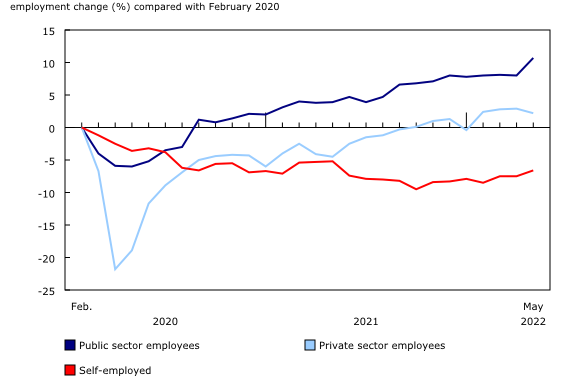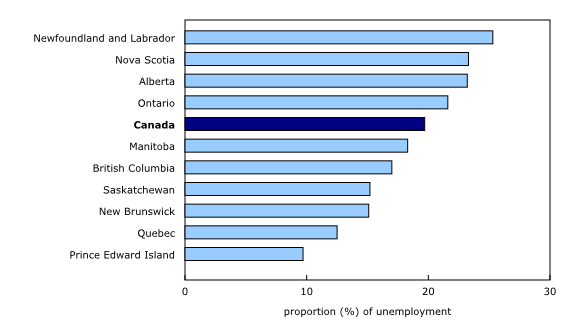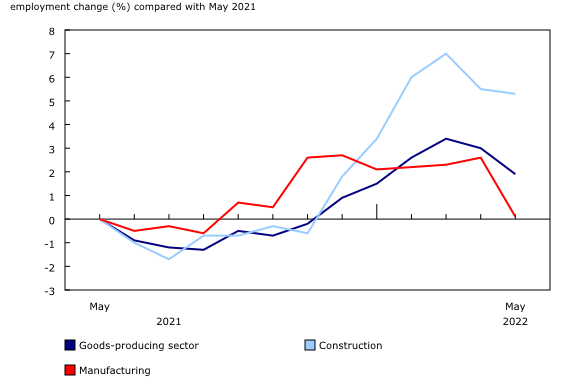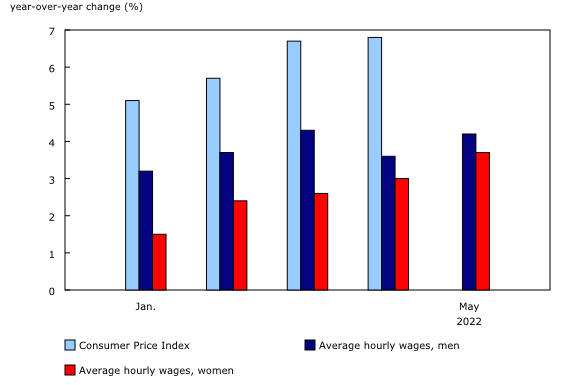Employment rose by 40,000 (+0.2%) in May and the unemployment rate edged down to 5.1%.
The employment increase was driven by gains in full-time work among young and core-aged women. The increase was spread across several industries, led by wholesale and retail trade, and was concentrated in Alberta.
Total hours worked were little changed in May, but were up 5.1% compared with 12 months earlier.
Average hourly wages increased 3.9% (+$1.18 to $31.12) on a year-over-year basis.
Chart 1
Upward trend in employment continues in May

Highlights
Employment increases in May
Employment rose by 40,000 (+0.2%) in May 2022, driven by full-time gains (+135,000; +0.9%).
Employment in the services-producing sector rose by 81,000 (+0.5%) in May, with gains spread across several industries, including accommodation and food services.
Employment in the goods-producing sector declined by 41,000 (-1.0%), mostly due to a decline in manufacturing (-43,000; -2.4%).
Employment increased in Newfoundland and Labrador, Prince Edward Island, and Alberta. It declined in New Brunswick and was little changed in all other provinces.
Total hours worked were little changed in May, but were up 5.1% compared with 12 months earlier.
Average hourly wages increased 3.9% (+$1.18 to $31.12) on a year-over-year basis, up from 3.3% in April.
Unemployment rate reaches new record low
The unemployment rate edged down 0.1 percentage points in May, reaching a new record low of 5.1%.
The adjusted unemployment rate—which includes those who wanted a job but did not look for one—fell 0.2 percentage points to 7.0% in May, the lowest rate on record since comparable data became available in 1976.
Long-term unemployment accounted for 19.7% of all unemployment in May, up from 15.6% in February 2020.
Full-time work drives employment growth
Amid a number of recent indicators of increasing labour demand and limited supply, employment growth resumed in May after pausing in April. Total employment increased by 40,000 (+0.2%) in May, including strong growth in full-time work (+135,000; +0.9%). Part-time employment dropped by 96,000 (-2.6%).
Employment growth in May due to gains among women across all age groups
Overall, employment gains were driven by increases for women in each of the three main age groups, while employment was little changed for men in each of the groups.
Among women in the core working ages of 25 to 54, full-time employment rose by 63,000 (+1.2%) in May, while part-time work fell by 41,000 (-4.0%). Similarly, for young women aged 15 to 24, full-time gains (+53,000; +10.0%) were greater than part-time losses (-37,000; -4.8%).
Among women aged 55 to 64, employment was little changed for a third consecutive month in May, after increasing in February (+21,000; +1.4%). Among the larger group of women aged 55 and older, total employment rose by 18,000 (+1.0%) in May.
Employment rate up year-over-year across diverse groups as labour market continues to tighten
Since May 2021, when the labour market was impacted by the third wave of the COVID-19 pandemic, total employment has increased by 1.1 million (+5.7%) and as of May 2022 was 497,000 (+2.6%) above its pre-COVID February 2020 level. As a result of this strong labour market recovery, the employment rate—or employment as a proportion of the population aged 15 and older—grew year over year, from 59.4% in May 2021 to 61.9% in May 2022.
Among those in the core working ages of 25 to 54, the employment rate was up 3.1 percentage points on a year-over-year basis to 84.6% in May.
Improvements in labour market conditions varied across the core-aged population from May 2021 to May 2022, with notable year-over-year increases being observed among First Nations women (+10.4 percentage points to 70.1%), South Asian women (+6.3 percentage points to 75.2%), Métis men (+4.9 percentage points to 84.1%), and Filipino men (+4.0 percentage points to 91.4%) (three-month moving averages, not seasonally adjusted).
Changes in the employment rate of diverse groups can be associated with many factors, including changes in the composition of employment by industry and occupation.
Absences due to illness or disability return to pre-pandemic level
Total hours worked were little changed in May, but were up 5.1% compared with 12 months earlier.
People absent due to illness or disability represented 6.2% of employees, slightly higher than its pre-pandemic average of 5.5% in the month of May from 2017 to 2019. The May 2022 percentage follows elevated levels, particularly in January 2022 when absences due to illness or disability affected 10.0% of employees.
The strong storm leading to prolonged power outages in some areas of Eastern Ontario and Western Quebec occurred on the last day of the reference week (Saturday, May 21) and did not impact hours worked in May.
Employment up in public sector, while self-employment still lagging below pre-COVID levels
The number of employees in the public sector rose by 108,000 (+2.6%) in May, driven by more public employees in educational services and health care and social assistance. The number of private sector employees fell by 95,000 (-0.7%), mostly due to fewer people working in manufacturing.
Following these monthly changes, gains in employment observed since the beginning of 2022 were similar for public (+113,000; +2.7%) and private (+314,000; +2.5%) sector employees.
Although self-employment was little changed on a monthly basis in May and remained lower than in February 2020 (-189,000; -6.6%), cumulative growth in the number of self-employed workers since October 2021 totalled 84,000 (+3.2%).
Chart 2
Modest growth in self-employment from October 2021 to May 2022

Unemployment rate reaches another record low
The unemployment rate edged down 0.1 percentage points to 5.1% in May, marking three consecutive months in which this key labour market indicator has reached a new record low. The rate was similar to or below previous all-time lows in four provinces: British Columbia (4.5%), New Brunswick (7.1%), Prince Edward Island (7.8%), and Newfoundland and Labrador (10.0%).
The unemployment rate for those aged 25 to 54 was 4.3% in May, matching the all-time low recorded in April 2022. The rate was little changed for both men (4.3%) and women (4.2%) in this age group in May.
The tightening labour market in recent months has contributed to year-over-year declines in unemployment rates across the core-aged population. Groups with notable year-over-year decreases in May included First Nations women (-9.3 percentage points to 7.3%), Southeast Asian women (-6.3 percentage points to 4.1%), and Filipino men (-4.7 percentage points to 3.4%) (three-month moving averages, not seasonally adjusted).
Among men aged 55 and older, the unemployment rate dropped 0.5 percentage points to 5.0% in May, while for women in this age group the rate was little changed at 4.1%.
After increasing in April, the unemployment rate among male youth aged 15 to 24 was little changed at 11.4% in May. The unemployment rate for female youth (8.1%) held steady for the third consecutive month.
Chart 3
Unemployment rate continues downward trend in May

Adjusted unemployment rate also hits record low in May
Based on results from the Job Vacancy and Wage Survey, the ratio of unemployed people to job vacancies reached an all-time low of 1.2 in March (not seasonally adjusted), highlighting labour supply pressures facing employers seeking to attract and retain employees.
One potential source of labour supply is those who are not actively participating in the labour force but report that they want to work. In May, there were 409,000 of these potential workers, down by 18,000 (-4.2%) from April. The adjusted unemployment rate—which includes those who wanted a job but did not look for one—fell 0.2 percentage points to 7.0% in May, the lowest rate on record since comparable data became available in 1976.
Long-term unemployment little changed at national level, but falls in Alberta
There were 208,000 people who had been searching for work or on temporary lay-off for 27 weeks or more in May, little changed for the third consecutive month. While many leading labour market indicators have recovered to pre-pandemic levels, long-term unemployment has remained elevated and accounted for 19.7% of all unemployment in May, up from 15.6% in February 2020.
The level of long-term unemployment is influenced by a number of factors, including geographic variations in the demographic composition of the labour force and in the match between the skills required for vacant positions and the skills of potential workers. In May, long-term unemployment as a proportion of total unemployment ranged from 9.7% in Prince Edward Island, to 25.3% in Newfoundland and Labrador. In Alberta, this proportion dropped from 31.8% in April to 23.2% in May, as the decline in overall unemployment (-15,000; -10.4%) was entirely among the long-term unemployed (-16,000; -34.7%).
Chart 4
Long-term unemployment varies by province

Record high labour force participation rate for core-aged population continues
The overall labour force participation rate, or the proportion of the population aged 15 and older that is either employed or unemployed, held steady at 65.3% in May.
The participation rate among core-aged women edged up to a record high of 85.0% in May, similar to the previous highs observed in March (84.8%) and April (84.9%) of 2022. Participation for core-aged men (91.9%) was little changed in May and was 0.4 percentage points below the record high observed in March 2022.
Among youth aged 15 to 24, labour force participation was little changed in May for both men (64.4%) and women (66.0%).
Participation rate down among men aged 55 to 64
Among men aged 55 and older, the participation rate dropped 0.6 percentage points to 41.9% in May, as there were 29,000 (-1.2%) fewer of them who were either employed or unemployed. For women in the same age group, the participation rate has remained at a similar level since July 2021 and was 31.7% in May.
As the labour force ages and a large cohort of Canadians approaches retirement, the labour force participation rate among 55 to 64 year olds (66.1%) is an important indicator of labour supply, particularly in the context of high unmet demand. While the participation rate (60.4%) was little changed for women aged 55 to 64 in May, it fell a full percentage point to 71.9% for men in the same age group.
Among adults aged 55 to 64, the participation rate in May ranged from 50.7% among First Nations people and 55.4% among Southeast Asian Canadians, to 76.6% among Black Canadians, 78.7% among Arab Canadians, and 82.3% among Filipino Canadians (three-month moving averages, not seasonally adjusted).
Employment up in the services-producing sector, down in the goods-producing sector
Employment in the services-producing sector rose by 81,000 (+0.5%) in May, with gains spread across several industries.
Employment rose in accommodation and food services (+20,000; +1.9%) for a second consecutive month, consistent with increases in both GDP in the industry (+10.9%) and food services sales (+6.5%) in March.
The number of people working in professional, scientific and technical services grew by 21,000 (+1.2%) in May, adding to the increase of 15,000 (+0.9%) seen in April, and bringing gains over the first five months of 2022 to 68,000 (+4.0%). A notable proportion of the increase in May in this industry occurred in Alberta (+11,000; +5.5%).
Employment also increased in educational services (+24,000; +1.6%) and retail trade (+34,000; +1.5%) in May, while both transportation and warehousing (-25,000; -2.4%) and finance, insurance, real estate, rental and leasing (-19,000; -1.4%) saw employment losses.
Overall employment in the goods-producing sector declined by 41,000 (-1.0%) in May. After trending upward from October 2021 to March 2022, employment in the goods sector had plateaued in April.
Employment in manufacturing fell by 43,000 (-2.4%) in May, erasing gains seen during the fall of 2021 and returning employment in the industry to a level on par with May 2021. Monthly decreases were seen in six provinces, with the largest recorded in British Columbia (-11,000; -5.8%), Ontario (-16,000; -2.0%) and Quebec (-7,700; -1.5%).
Employment held steady in construction in May, after falling in April. Employment in the industry had been trending upward from November 2021 to March 2022, and was up 5.3% on a year-over-year basis in May.
There were 8,300 (+2.5%) more people working in natural resources in May, the third increase in five months. Gains in May were led by Quebec (+2,100; +4.3%).
Chart 5
Employment in goods-producing sector falls in May

Employment up in two Atlantic provinces and in Alberta
Employment increased in Newfoundland and Labrador, Prince Edward Island, and Alberta in May. It decreased in New Brunswick and was little changed in all other provinces. For further information on key province and industry level labour market indicators, see “Labour Force Survey in brief: Interactive app.”
In Newfoundland and Labrador, employment rose (+4,100; +1.8%) in May, the third increase in four months. Whereas the provincial unemployment rate (10.0%) remained the highest among all provinces, the rate for the census metropolitan area (CMA) of St. John’s was 6.8% (three-month moving average).
Prince Edward Island also saw an employment increase in May (+1,100; +1.3%), while the unemployment rate was little changed at 7.8%.
In Alberta, employment grew by 28,000 (+1.2%) in May, building on gains in April. The unemployment rate decreased 0.6 percentage points to 5.3%. Professional, scientific and technical services (+11,000; +5.5%) and transportation and warehousing (+8,000; +6.6%) were the primary contributors to the employment gains in Alberta.
New Brunswick was the lone province with a drop in employment in May (-3,900; -1.0%), partially offsetting gains in March and April. The unemployment rate was little changed at 7.1%.
In Quebec, employment was little changed in May, following a decline in April, as growth in full-time employment was offset by part-time losses. With more people participating in the labour market and little employment change, the unemployment rate rose 0.3 percentage points to 4.2%.
In Ontario, both employment and the unemployment rate (5.5%) held steady for the second consecutive month in May.
Employment rate in Canada continues to trend higher than in the United States
By adjusting Canadian data to US concepts, comparisons can be made between the labour market situation in Canada and in the United States. For more information, see “Measuring Employment and Unemployment in Canada and the United States – A comparison.”
The unemployment rate, adjusted to US concepts, was 4.1% in Canada in May, 0.5 percentage points higher than in the United States (3.6%).
Also adjusted to US concepts, the employment rate was 62.4% in Canada and 60.1% in the United States in May. The employment rate, defined as employment as a percentage of the working-age population, is typically higher in Canada.
The labour force participation rate, adjusted to US concepts, was 65.1% in Canada and 62.3% in the United States in May. Among Canadians aged 25 to 54, the rate was 87.7% in May, up 1.2 percentage points from February 2020. In contrast, core-aged participation in the United States in May 2022 was 82.6%, slightly lower than the pre-pandemic February 2020 rate (83.0%).
In the spotlight: wage growth, student employment, and work location
Growth in average wages accelerates
In recent months, the tightening labour market and rising inflation have highlighted the importance of a range of wage indicators for understanding whether the paycheques of Canadians are keeping pace with the rising cost of goods and services. Average hourly wages for all employees rose 3.9% (+$1.18) on a year-over-year basis in May, up from 3.3% in April. Faster increases were seen among some groups of workers. For example, wages increased among both permanent (+4.5%) and full-time (+4.3%) employees.
Year-over-year growth in average wages also differs between men and women. In May, average wages were up 4.2% year over year among men, compared with 3.7% among women. This difference has narrowed since the beginning of 2022, as wages among men held steady from January to May, while wages among women grew by 1.2%. Year-over-year wage growth among both men and women was slower than the pace of growth in the Consumer Price Index (CPI) as of April (+6.8%).
Recent differences in the wage growth of men and women have likely been influenced by a number of factors, including seasonal variation in employment, which differ across groups of workers. More generally, gender wage gaps are due in part to differences in the industries and occupations in which men and women work. For more information on the historical impact of compositional differences of employment on the gender wage gap, see “The gender wage gap in Canada: 1998 to 2018.”
Chart 6
Wage growth for both men and women lags growth in the Consumer Price Index

Taking a longer term view, wages have grown more among women (+17.8%) than among men (+14.9%) since January 2018.
For both women and men, wage changes observed since the onset of the pandemic have been influenced by shifts in the relative composition of employment, for example from lower-wage to higher-wage industries. Most of the highest-wage industries have seen strong employment growth over the past three years, while employment in most of the lowest-wage industries has stalled or decreased. This compositional shift alone has put upward pressure on the average wage, regardless of any changes in individual pay.
Chart 7
Average hourly wages up more among women than men since 2018

A range of indicators paint a more complete picture of wage dynamics
Understanding the dynamics of wage changes—and their relationship to rising consumer prices—requires a range of indicators above and beyond average hourly wages from the Labour Force Survey (LFS), including indicators from the Job Vacancy and Wage Survey (JVWS). For example, from March 2019 to March 2022, recently-hired employees saw wage gains (+16.5%) which were greater than both the CPI (+10.0%) and the average for all employees (+12.4%), in part a reflection of some job changers having above-average work experience and earning power. On the other hand, from the first quarter of 2019 to the fourth quarter of 2021, the offered wages associated with vacant positions (+5.3%), measured in the JVWS, grew more slowly than the CPI, suggesting limits in the ability of some employers to raise pay levels. For more information on a range of wage indicators, see “Disaggregating wage growth: Trends and considerations.”
Other sources can shed further light on how employers plan to adapt to changing consumer prices. For example, according to the Canadian Survey on Business Conditions, over half of businesses (55.2%) in the second quarter of 2022 expect inflation to be a bigger issue when discussing wage increases with employees over the next 12 months, including over three-quarters of businesses in accommodation and food services (not seasonally adjusted). In early 2022, over 4 in 10 businesses (44.9%) indicated that they plan to increase wages offered to existing employees over the next 12 months (not seasonally adjusted).
Students see record high start to the summer job season
During the summer months, from May to August, the LFS captures labour market information for youth aged 15 to 24 who were full-time students in March and intend to return to school in September. This information helps to shed light on the experiences of returning students seeking to gain work experience and to fund their continuing education. Youth in general have been hard-hit by employment disruptions throughout the pandemic, with young women in particular not recovering their February 2020 employment level until August 2021.
Returning students aged 15 to 24 benefitted from favourable labour market conditions in May, with nearly half (49.8%) being employed. This was 2.8 percentage points higher than before the COVID-19 pandemic in May 2019 (47.0%) and well above the level in May 2021 (39.5%), when students seeking to pay for their fall studies continued to face labour market challenges resulting from COVID-19.
Among female returning students, the May employment rate (53.3%) was 1.5 percentage points higher than the previous record high for the month of May, observed in 2019. Similarly, the unemployment rate for this group was the lowest May rate on record, at 10.2% in May 2022.
Among male returning students, the May employment rate (45.8%) was 4.0 percentage points higher than in 2019 and the highest since May 1991, while the May unemployment rate (13.0%) was the lowest since 1990.
Student employment rates tend to increase through June and July, as more youth—particularly teens—finish their school year and enter the labour market.
Chart 8
Employment rate for returning students surpasses pre-pandemic May 2019 level

Among returning students, average hourly wages for employees were up 5.7% year over year (+$0.90 to $16.82) in May, including a 10.5% year-over-year increase in wages for students working in the accommodation and food services industry (+$1.52 to $15.99). Wages for students in this industry were likely impacted by increases to minimum wages introduced by several provinces in 2022, and the elimination of the special minimum wage for liquor servers in Ontario in January 2022.
More than one-quarter of employees have flexibility to choose their work location
As of May, just under 1 in 5 (19.2%) employed Canadians reported that they usually work exclusively from home, similar to the proportion in April. The proportion of workers with a hybrid work arrangement—that is, those who usually work both at home and at locations other than home—increased slightly in May (+0.5 percentage points to 6.3%), continuing a slow upward trend observed since January (population aged 15 to 69; not seasonally adjusted).
With the lifting of most COVID-19 public health restrictions in the past few months, and in the context of increased competition for a limited supply of labour, many employers have been faced with the choice of whether to require employees to return to the office, or to provide them the option of continuing to work from home, either exclusively or in combination with some in-person work. In May, 27.9% of employees reported that they were able to choose their work location at least some of the time, including 13.9% who were able to choose all of the time (population aged 15 to 69; not seasonally adjusted).
The flexibility of employees to determine their work location at least some of the time was highest in professional, scientific and technical services (64.3%) and finance, insurance, real estate, rental and leasing (57.4%) (population aged 15 to 69; not seasonally adjusted).
Among employees who were able to choose their work location at least some of the time, 45.0% reported that they work exclusively from home, while 1 in 6 (15.7%) had a hybrid work arrangement.













